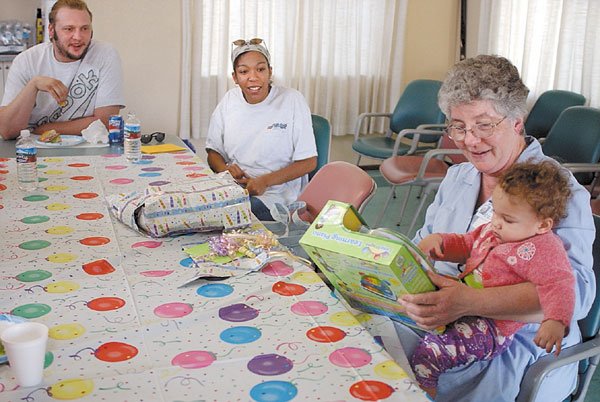South Valley residents aid Hurricane Katrina survivors, making
their challenges a little easier to bear
It has been six months since Hurricane Katrina destroyed all of Wesley Jackson’s belongings except the pair of pants, two shirts and television set he was able to remove from his apartment.
Today is another step toward normal. Today he wakes up in his Morgan Hill apartment knowing that his daughter Natalie, age 1, has toys. Today he knows there is food in the refrigerator for his partner, Jade Reedus.
And he knows the place he left is still in ruins.
“I’m glad I’m now able to provide a few dollars for myself,” said the 23-year-old Jackson who works part-time at a local restaurant. “We’re on schedule; we’re fine. But there’s people walking around down there homeless, with kids.”
Down there is Long Beach, Miss. It was blitzed by Hurricane Katrina. Jackson and Reedus lived in an apartment close to the beach on the Gulf Coast, and they fled a few miles inland to wait out the storm. When Jackson returned to check on things, he knew immediately their lives would not be the same.
His car was smashed by a tree. Natalie’s room and the bathroom lost their roofs. Drywall and other debris destroyed the contents of the apartment, even crashing down on Jackson’s pet snakes, killing them. All photographs of Natalie were ruined.
Much of the rest of the town got it worse. Photographs show areas that look more like scorched earth – grids of foundations the only remaining signs of an entire neighborhood, hundreds of vehicles strewn like leaves on a lawn.
“When something like that happens you lose all sense of time,” said Jackson who has been in the South Valley for about three months. “Everybody down there went into survival mode, and I’m still doing it. Now that I’m here, it’s kind of hard to get back out into the real world.”
This morning, Jackson wakes knowing his roof is secure. Residents of South Valley have helped the family achieve a semblance of ordinary daily life. Today, when Natalie wakes up, she will toddle around her own room and play with toys provided by everyone from local Girl Scouts to South County Housing. The family has clothing, furniture, even a computer because of the generosity of local people.
Girl Scout Troop 1389 donated Christmas gifts to survivors of the storm. The Gilroy Foundation donated $2,800 to South County Housing. Gilroy’s South Valley Community Church donated $6,000 to South County Housing; Paine’s Restaurant in Hollister gave $1,000; a benefit organized by the Gilroy Ministerial Association raised $1,400; and a Live Aid concert in Gilroy organized by South Valley Newspapers raised $6,000 for the American Red Cross. Schoolchildren at El Roble School in Gilroy recently raised $500 to contribute. Local residents donated cars, furniture and more.
The community enabled Jackson, Reedus and Natalie to enjoy a real Christmas. Reedus is grateful for the items.
“Yesterday, I soaked my feet in the foot spa the Scouts gave me,” she said. “They gave her (Natalie) a thing to walk behind, and that’s how she learned to walk.”
Today, Jackson can show visitors around the apartment provided by South County Housing. It is clean, cozy, comfortable.
“They got here at Thanksgiving with 50 cents in their pocket. The first thing we did was get them some cash funds,” said Phil Vargas, Neighborhood Developer for South County Housing. “They are doing real good. They came with a lot of hopes and dreams, so we’re trying to help facilitate them.”
A relative provided the 1999 Chevrolet Cavalier that the family loaded up with their cardboard box of belongings and drove to California from Mississippi. Reedus grew up in San Jose, which is why they decided to head west. Her mother and grandmother, however, had moved to the South to be closer to Reedus and Natalie. Southwest Airlines has donated a plane ticket, and when the timing is right, Jackson said he will fly out and drive back family members wishing to return to California.
It seems likely that her mother and grandmother will want to come out, considering that Reedus is pregnant with the couple’s second child.
Today, Jackson and Reedus are able to concentrate on the rhythms of daily life. The transition is easier for Reedus because of her familiarity with the area. Her day is spent tending to the needs of her child, home and family.
And yet, not long ago, things were very different.
“We had nothing, so we tried to start all over again,” said Reedus, 24. “People here have been really, really nice. Kind. I’m glad they had help waiting for people, so I could come home.”
Jackson will spend his day making the transition from disaster to daily life – in a new home that in some ways is like another country. California is not Mississippi. Daily life here is much faster. While he appreciates that Morgan Hill and Gilroy are pretty small, he has yet to match the speed and stress of West Coast living.
Today, someone, probably Reedus and her friends, will talk so fast they’ll “sound like motorboats” to Jackson. His speech is slower; he “draws” his words out. He will work at his job at the restaurant, and the pace will be stressful. He will come home, have a smoke on the balcony, and relax with Reedus and Natalie, maybe watch TV, play a video game or begin a new highly detailed pencil drawing, probably of a dragon.
And he will continue filling out the paperwork and application to a culinary school he wants to attend.
Today he may also visit a counselor to talk. He sometimes feels something like post-traumatic stress from the hurricane, and it helps to talk to someone about it.
And another day, Natalie was to have a birthday party – her first.
South County Housing was throwing it for her, at Wheeler Manor in Gilroy. A lot of people from the community, people who have helped and haven’t gone away, were expected to attend. Reedus thought she might feel a little embarrassed by the whole thing, because she doesn’t like a fuss made over her. Jackson knew he would not be inconspicuous, because he is 6-feet-7.
And Natalie had one heck of a great time.
And when the day was done, Jackson probably said what he has been quietly saying for a while now, that he’d like to stay here.
“I called a friend back home, and it definitely ain’t back to normal there,” he said. “Some of his friends didn’t make it, some of my friends didn’t make it.
“California did its magic on me. We’re not going anywhere.”
Hurricane Katrina facts
Hurricane Katrina was so destructive that the numbers are staggering to digest. Yet it helps to know how powerful it became and how widespread the damage was felt.
Here are some Katrina facts:
n It formed over the Bahamas on Aug. 23, and by the time it hit the Gulf of Mexico on Aug. 29, it was the most powerful hurricane ever recorded. Hurricane Rita, later in the season, eclipsed that record.
– Its winds reached 175 mph.
– So far, it has done $75 billion in damage, making it the costliest tropical storm of all time.
– There were 1,417 known fatalities. As of Jan. 18, 3,200 people remain unaccounted for.
– 1.2 million people were ordered evacuated before the storm hit land.
– It flooded 80 percent of the city of New Orleans.
– It is the most expensive natural disaster in the history of the United States.
– Federal disaster declarations blanketed 90,000-square miles, an area about the size of the UK.
– The Federal Emergency Management Agency placed 30,000 temporary housing units in Louisiana and 50,000 in Mississippi.
– The federal government has provided assistance to 700,000 people.
– The storm surge that hit Mississippi peaked at 34 feet.
– 238 of the 1,417 fatalities were in Mississippi.
Sources: National Hurricane Center; National Weather Service; FEMA; various federal agencies.














